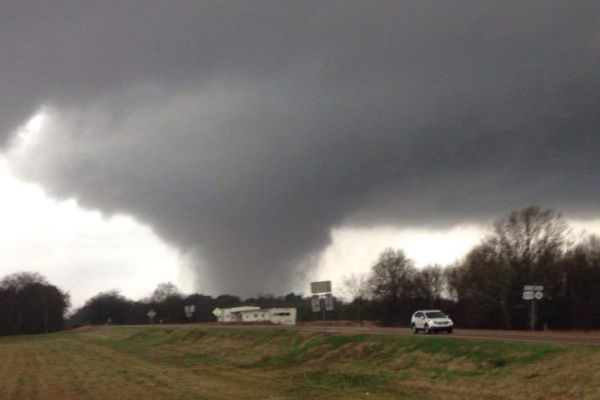
- Details
- By Ben Pryor
In late March, at least 27 tornadoes hit Tennessee, Mississippi, and Alabama in the southern U.S., resulting in numerous casualties and injuries.
And while many think of tornado season as being in the spring and summer, more than 300 tornadoes struck 16 states last winter, as temperatures continue to climb and impact everyday life. Those tornadoes are striking states in the southeast more frequently, too–as far east as Georgia, some 400-500 miles east of the “Tornado Alley” of Oklahoma and Texas.
That “Tornado Alley” is seeing the risk of wildfires is rising, while studies show that tornadoes are growing in intensity and are more likely to develop as clusters rather than singular spin-up events, posing an even greater risk to residents.
“Our region has always experienced tornadoes, but over the last five to six years, we have seen an increased trend in the frequency of storms with more distinctive tornadic activity,” April Sells, Poarch Band of Creek Indians (Alabama), Tribal Emergency Management Administrator (EMA) Director, told Native News Online. “Our tornado season used to just occur in the Spring between May through June, but now we are seeing these severe weather systems almost quarterly.”
Poarch Band has worked hard to establish a close relationship with the National Weather Service (NWS), a crucial partnership which aids the Poarch Band’s severe weather preparations. The alliance represents a vital safeguard against the dangers of unpredictable weather patterns, ensuring that they remain prepared and vigilant in the face of any potential threats.
“We have relationships with both locations because the Mobile branch covers the Poarch reservation as well as our Wind Creek Casino & Hotel in Atmore,” said Sells. “The Birmingham office provides weather updates for our casino operations in Wetumpka and Montgomery. These partnerships with NWS allow us access to their annual meetings which provide storm predictions.”
In 2011, Alabama was hit by over 65 tornadoes in a single day, causing severe damage and loss of life, particularly in Tuscaloosa. Republican then-governor Robert Bentley declared a state of emergency, authorizing emergency funds for severe weather programs and recovery efforts–some of which were dedicated to mitigating future severe weather events, including constructing public tornado shelters on the Poarch Band of Creek Indians' reservation. As a result, the tribe is now better equipped to face future storms.
The Poarch Band also established a reimbursement program for tribal members to purchase personal storm shelters. It implemented an outdoor notification system to alert them, employees, and casino guests of severe weather within a 10-mile radius. They also use software to send instant alerts via text, automated phone calls, and emails when severe weather is imminent. With the state of Alabama’s dedicated computer and radar tracking program, the Tribal EMA Team can monitor severe weather situations and report potential issues through various communication platforms.
“The statistics do show that this is happening,” said Howard Bluestein, a research professor at the University of Oklahoma. But he cautioned that given the historic rarity of tornadoes in the southeast, more research there needs to be done.“If the Earth’s climate warms, especially with warming occurring more at high latitudes than warming at low latitudes, then the jet stream pattern, which controls our day-to-day weather, may change,” said Bluestein.
Bluestein suggests people listen to weather forecasts in the morning and be aware of what might happen later in the day. If a tornado watch is issued, be sure to monitor TV, radio, NOAA weather radio, and online weather bulletins, especially warnings. If a tornado warning is issued, go to a nearby shelter or an underground basement. He also recommends having a plan ready in advance on what to do. In case of a tornado, go to an interior room, away from windows in the lowest part of the building. Protect yourself from flying debris and keep your head and neck safe. If you're outside or in a car, find a low area like a ditch to lie down and keep safe. If in a mobile home, it is advised to leave immediately and seek sturdier shelter.
And consult with your Tribe’s Emergency Management department for more information on preparedness in your community.
More Stories Like This
Klamath Indigenous Land Trust Purchases 10,000 Acres as Salmon ReturnTrump signs law that revokes some limits on drilling in Alaska’s National Petroleum Reserve
Southern Sierra Miwuk Nation Gets 900-Acres ofLand Back
Chilkat Indian Village Tells New Palmer Mine Owners They Are “Not Welcome” in Chilkat Valley
Tribes, Coastal Group Ask Army Corps to Revoke Permit for Texas Export Terminal
Help us defend tribal sovereignty.
At Native News Online, our mission is rooted in telling the stories that strengthen sovereignty and uplift Indigenous voices — not just at year’s end, but every single day.
Because of your generosity last year, we were able to keep our reporters on the ground in tribal communities, at national gatherings and in the halls of Congress — covering the issues that matter most to Indian Country: sovereignty, culture, education, health and economic opportunity.
That support sustained us through a tough year in 2025. Now, as we look to the year ahead, we need your help right now to ensure warrior journalism remains strong — reporting that defends tribal sovereignty, amplifies Native truth, and holds power accountable.
 The stakes couldn't be higher. Your support keeps Native voices heard, Native stories told and Native sovereignty defended.
The stakes couldn't be higher. Your support keeps Native voices heard, Native stories told and Native sovereignty defended.
Stand with Warrior Journalism today.
Levi Rickert (Potawatomi), Editor & Publisher


